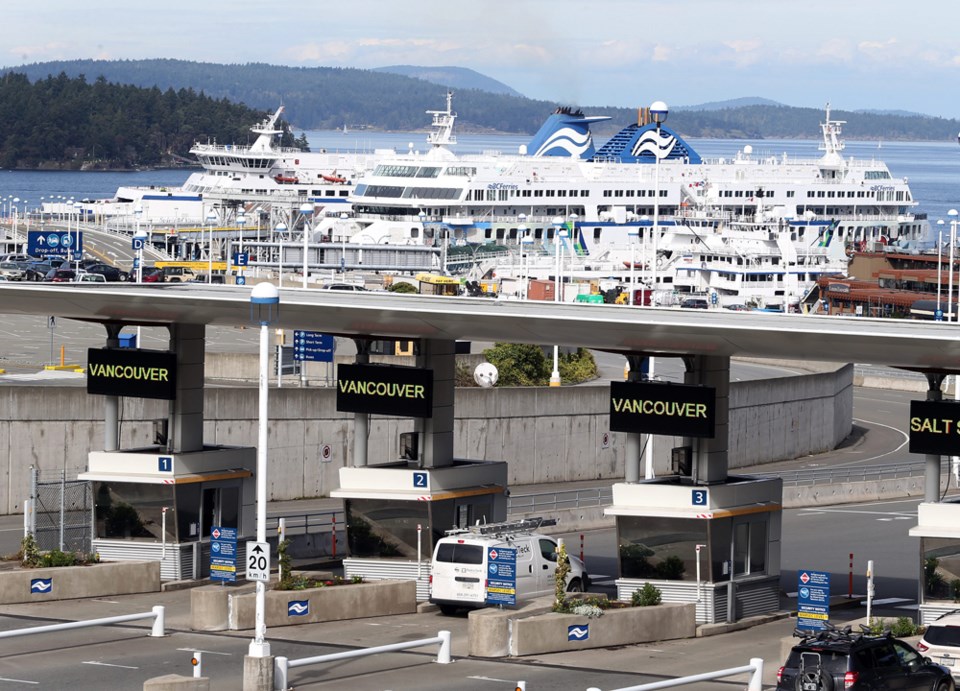B.C. Ferries plans to build at least five new large ferries to serve Vancouver Island and the Lower Mainland, at a cost that could reach $1 billion — and it’s leaving open the possibility of building two or three more.
“Wow. That’s pretty amazing,” said George MacPherson, president of the Shipyard General Workers’ Federation, who could not recollect a past ferry order of similar magnitude.
The five would replace four C-class ferries built between 1964 and 1981 and add another to deal with predicted growing demand. A request for expressions of interest has been issued and is open to Canadian and international firms.
The five new ships would be built with the ability to make adjustments if travelling patterns change — for example, a car deck could be converted for passenger use if demand for on-board vehicle space drops. The vessels will also be quieter to reduce underwater noise for killer whales, and have lower emissions.
“These vessels will be quieter and have a lighter ecological footprint than any we have ever built,” said Mark Wilson, vice-president of strategy and community engagement for B.C. Ferries.
“We are building the low-carbon coastal ferry system that will service B.C. for the middle half of this century.”
The vessels will be similar in capacity to the Spirit-class and Coastal-class ferries, which can each carry between 1,600 and 2,100 passengers and crew, and 310 to 358 cars.
“This will be one of the largest serious builds that we have done in the last two decades at least,” Wilson said.
The new vessels, which can be loaded on both ends, would begin to come into service in 2023, with each arriving about six months apart.
B.C. Transportation and Infrastructure Minister Claire Trevena called the construction plan a “wonderful opportunity” for B.C. “Our government has been very clear. We would like to see ferries built in British Columbia.”
B.C. yards could build segments of ferries, Trevena suggested, or one ferry could be built elsewhere, with subsequent builds in B.C. yards using the blueprints.
B.C. Ferries is encouraging B.C. and Canadian shipyards to respond to its request for expressions of interest, but the contract won’t specify Canadian or local content.
“It is the ferry users that are paying for these new vessels,” Wilson said. “At the end of the day, we want to look out for the ferry users of British Columbia. Their number-one concern is around fare affordability.”
He said the total project costs for the first five new vessels could reach $700 million to $1 billion.
The three Coastal-class vessels built in Germany came with a price tag totalling just over $500 million a decade ago.
Designs have not been drawn up yet, but Wilson anticipates the new vessels will be 160 to 180 metres long (525 feet to 590 feet), which could make some of them longer than the two Spirit-class vessels — the two biggest vessels in the fleet at 167 metres (547 feet and 11 inches).
Wilson expects they will be hybrid ferries, using liquefied natural gas as the primary fuel with batteries on board.
Expenditures of this size must be approved by the B.C. Ferry Commissioner. An application will go to that office next year. If it’s approved, a contract would be awarded by the end of 2019.
The new ferries will replace the Queen of Alberni, Queen of New Westminster, Queen of Cowichan and Queen of Coquitlam. The other C-class vessels, the Queen of Oak Bay and the Queen of Surrey, won’t be replaced until the late 2020s or early 2030s.
Current plans call for five, but “there’s potential for two to three more of this class,” Wilson said.
C-class ferries serve routes including Duke Point-Tsawwassen, Departure Bay-Horseshoe Bay and Horseshoe Bay-Langdale. The new vessels could also be used on the Swartz Bay-Tsawwassen route.



